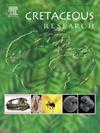伊朗西部扎格罗斯盆地上白垩统—下古新统钙质纳米化石生物地层学
IF 1.7
3区 地球科学
Q1 GEOLOGY
引用次数: 0
摘要
对伊朗Zagros盆地Kabir Kuh背斜东北翼Garab剖面上白垩统和下古新统钙质纳米化石生物地层学进行了研究。结果显示了一个相对完整的记录,跨越了塞诺曼尼亚到丹尼尼亚阶段。该剖面底部含有艾菲ellithus turriseiffelii,表明其位于UC0生物带或以上,而在68.8 m处出现的corollithon kennedyi证实其位于Cenomanian。上坎帕统古尔皮组缺少UC15a-b生物带,提示不整合。Cenomanian/Turonian Boundary (CTB)和Oceanic Anoxic Event 2 (OAE2)的特征是存在大量的小类群,包括brustum constans、Discorhabdus ignotus和Zeugrhabdotus noeliae,其中后两个类群是OAE2期间地表水肥沃度的指标。白垩纪-古近纪界线(KPB)以brarudosphaera bigelowii和Neobiscutum sp.等钙质纳米化石的丰度增加和钙质鞭毛藻的快速增加为标志。我们的研究结果表明,在其他特提斯地区观察到的OAE2期间,纳米化石的生产力很高,KPB的灾难分类群(如Braarudosphaera bigelowii和Neobiscutum spp.)的更替和增殖也很快。这些结果大大提高了我们对这些地质事件的认识,并表明Garab剖面是进一步研究Cenomanian/Turonian边界和K/Pg边界的有力候选者。本文章由计算机程序翻译,如有差异,请以英文原文为准。
Calcareous nannofossil biostratigraphy of the upper Cretaceous to lower Paleocene in Zagros Basin, western Iran
Calcareous nannofossil biostratigraphy has been investigated for Upper Cretaceous and lowermost Paleocene deposits in the Garab section located on the northeastern limb of the Kabir Kuh Anticline, Zagros Basin (Iran). The results reveal a relatively complete record that spans the Cenomanian to Danian stages. The base of the section contains Eiffellithus turriseiffelii, implying placement in or above the UC0 Biozone, and the occurrence of Corollithion kennedyi at 68.8 m confirms placement in the Cenomanian. An unconformity is suggested by the missing UC15a-b Biozone in the upper Campanian Gurpi Formation. The Cenomanian/Turonian Boundary (CTB) and Oceanic Anoxic Event 2 (OAE2) is characterized by abundant small taxa including Biscutum constans, Discorhabdus ignotus, and Zeugrhabdotus noeliae, among which the last two taxa are indicators of surface-water fertility during OAE2. The Cretaceous/Paleogene Boundary (KPB) is marked by an increase of abundance of calcareous nannofossils such as Braarudosphaera bigelowii and Neobiscutum spp. and a rapid increase of calcareous dinoflagellates. Our results document high nannofossil productivity during the OAE2, as observed in other Tethyan locations, and rapid turnover and proliferation of disaster taxa such as Braarudosphaera bigelowii, and Neobiscutum spp. at the KPB. These results significantly enhance our understanding of these geological events and suggest that the Garab section is a strong candidate for further study of both the Cenomanian/Turonian boundary and K/Pg boundary.
求助全文
通过发布文献求助,成功后即可免费获取论文全文。
去求助
来源期刊

Cretaceous Research
地学-地质学
CiteScore
4.10
自引率
19.00%
发文量
235
审稿时长
12 weeks
期刊介绍:
Cretaceous Research provides a forum for the rapid publication of research on all aspects of the Cretaceous Period, including its boundaries with the Jurassic and Palaeogene. Authoritative papers reporting detailed investigations of Cretaceous stratigraphy and palaeontology, studies of regional geology, and reviews of recently published books are complemented by short communications of significant new findings.
Papers submitted to Cretaceous Research should place the research in a broad context, with emphasis placed towards our better understanding of the Cretaceous, that are therefore of interest to the diverse, international readership of the journal. Full length papers that focus solely on a local theme or area will not be accepted for publication; authors of short communications are encouraged to discuss how their findings are of relevance to the Cretaceous on a broad scale.
Research Areas include:
• Regional geology
• Stratigraphy and palaeontology
• Palaeobiology
• Palaeobiogeography
• Palaeoceanography
• Palaeoclimatology
• Evolutionary Palaeoecology
• Geochronology
• Global events.
 求助内容:
求助内容: 应助结果提醒方式:
应助结果提醒方式:


